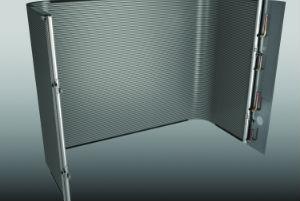 Here are some of the reasons why aluminum coils are becoming a major trend within the HVAC sector.
Here are some of the reasons why aluminum coils are becoming a major trend within the HVAC sector.
by Tad Sodergren*
There are numerous reasons that explain the trend towards the manufacture of coils entirely in aluminum, from the high cost of copper, to the lack of sources of supply around the world.
However, one of the main reasons in our industry has been the new regulations. At the end of the day, the industry is heading in that direction to reasonable price stability. In addition, this trend complies with the regulations on refrigerants. Not forgetting the success that the automotive industry has had with similar evaporative condensers in vehicles.
Let's take a look at the story, is there anything really novel?
The exclusive use of aluminum basically began in the automotive industry in the 90s. The automotive industry was then facing manufacturing challenges similar to those we have today in the HVAC systems sector, such as being forced to switch to R-134a refrigerant that operates at a slightly higher pressure. Manufacturers recognize that these changes cause great challenges when designing coils, as well as recognize that technicians and installers are headaches in adopting new installation techniques.
The automotive industry was forced to find an alternative with two fundamental goals in mind: to improve performance and to reduce size and weight. As is well known, currently all vehicles use aluminum in their coils, with the so-called microchannel technology.
The reader may think "yes, but that happens in the car business". Well, if we go back a little in time we will find that General Electric invented in the 60s a coil made all of aluminum called Spine Fin, which was later acquired by Trane. In fact, Trane has been successfully employing coils made of aluminum since the '70s.
Due to the high costs of copper, the high refrigerant pressure and the need for better efficiency, our entire HVAC industry is adopting the use of coils made entirely of aluminum.
The new coils have three components: aluminum channel, aluminum fins and two valves. The three components are welded together in a hydrogen/nitrogen furnace. This ensures a better process in the manufacture of the coil, compared to the traditional welding of return curves and collectors, which can involve a huge amount of welding and consequent increase in leaks in the manufacturing process.
It is necessary to evaluate the origin of the negative comments and common problems reported, which usually come from technicians and installers, due to ignorance about the new trend.
Technicians consider that all changes that occur in the industry are due to equipment problems or failures. And let's be honest, no one likes change. But there's a lot of misinformation in the industry, starting with beliefs like "these coils are more complicated than conventional copper/aluminum coils" or "require more accurate loading and are prone to more repairs than conventional copper/aluminum coils."
Like any conventional installation process it is necessary to implement the following practices:
• Weld the connections with nitrogen.
• Install a filter dryer from the liquid line.
• Use the triple evacuation method.
• Balance any additional loads.
There are also standardized procedures for copper/aluminum systems, which, generally speaking, have not changed. As for charging, less refrigerant is required. This allows for reduced loading time, but there is also less room for error. If you follow the manufacturer's instructions, no inconvenience should occur.
Another important issue is the cleaning of the coils. If you look closely at a coil, you will see that due to the hard welding process the coil fins made all of aluminum are much stronger than conventional units with copper tube and aluminum fins. In a copper and aluminum coil, a low-pressure cleaner and an upward and downward movement should be used to ensure that the fins do not bend, and thus avoid causing a restriction of air flow, which causes loss of heat transfer. Coils with microchannel or Environ technology made entirely of aluminum are very resistant and can be washed under high pressure in any direction, which allows you to have a clean coil without the need for chemicals.
Finally, there is the issue of reparations. As with any other coil, you should always go to the manufacturer to perform any repair procedure. If the technician studies the instructions of the manufacturers, you should not have any problems repairing the aluminum coils.
In general, over the years our industry has always been changing its standards without major inconveniences. Thus, we went from reciprocating compressors to Scroll compressors, from refrigerant R-22 to R410a. These and other changes are necessary, we must adopt them to ensure a better future.
So the next time a person tells you "I don't like this," make sure they don't say it simply because they don't like the change. Help him understand that if we don't embrace change we will be left behind.
* Tad Sodergren is the global sales manager (Andean Region) of Lennox. You can be contacted at email













